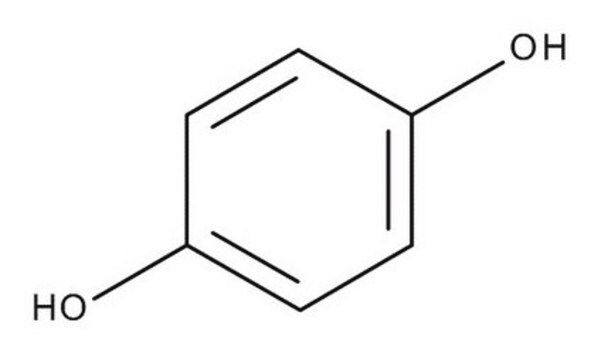1324002
USP
Hydroquinone
United States Pharmacopeia (USP) Reference Standard
Synonym(s):
1,4-Benzenediol, 1,4-Dihydroxybenzene, HQ
About This Item
Recommended Products
grade
pharmaceutical primary standard
vapor density
3.81 (vs air)
vapor pressure
1 mmHg ( 132 °C)
API family
hydroquinone
autoignition temp.
930 °F
manufacturer/tradename
USP
bp
285 °C (lit.)
mp
172-175 °C (lit.)
application(s)
pharmaceutical (small molecule)
format
neat
SMILES string
Oc1ccc(O)cc1
InChI
1S/C6H6O2/c7-5-1-2-6(8)4-3-5/h1-4,7-8H
InChI key
QIGBRXMKCJKVMJ-UHFFFAOYSA-N
Looking for similar products? Visit Product Comparison Guide
General description
Application
Also, for use with USP monographs such as:
- Hydroquinone Cream
- Hydroquinone Topical Solution
Analysis Note
Other Notes
related product
Signal Word
Danger
Hazard Statements
Precautionary Statements
Hazard Classifications
Acute Tox. 4 Oral - Aquatic Acute 1 - Aquatic Chronic 1 - Carc. 2 - Eye Dam. 1 - Muta. 2 - Skin Sens. 1B
Storage Class Code
11 - Combustible Solids
WGK
WGK 3
Flash Point(F)
329.0 °F - closed cup
Flash Point(C)
165 °C - closed cup
Regulatory Listings
Regulatory Listings are mainly provided for chemical products. Only limited information can be provided here for non-chemical products. No entry means none of the components are listed. It is the user’s obligation to ensure the safe and legal use of the product.
PRTR
Class I Designated Chemical Substances
ISHL Indicated Name
Substances Subject to be Indicated Names
ISHL Notified Names
Substances Subject to be Notified Names
JAN Code
1324002-500MG:4548173350325
Choose from one of the most recent versions:
Certificates of Analysis (COA)
Sorry, we don't have COAs for this product available online at this time.
If you need assistance, please contact Customer Support.
Already Own This Product?
Find documentation for the products that you have recently purchased in the Document Library.
Customers Also Viewed
Our team of scientists has experience in all areas of research including Life Science, Material Science, Chemical Synthesis, Chromatography, Analytical and many others.
Contact Technical Service








